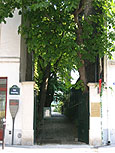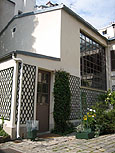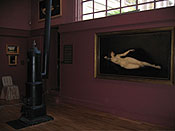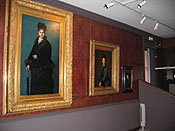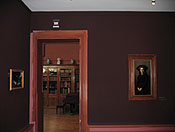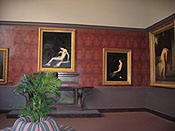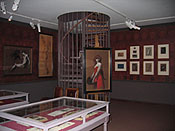The browser will either open the file, download it, or display a dialog.
|
Jean-Jacque Henner Face à l'Impressionnisme, Le dernier des romantiques Musée de la Vie Romantique, Paris Jean-Jacques Henner, Face à l'Impressionnisme, Le dernier des romantiques, |
|||
| The recent exhibition dedicated to the work of the academic Salon painter Jean-Jacques Henner, in Paris at the Musée de la Vie Romantique, raised a series of issues that are worth considering (figs 1, 2). If Henner is known at all, it is only to a few students of nineteenth century art, and more for his symbolist works of women with long red hair than for any other subject. Even though he is of interest to some historians and curators of the nineteenth century, his prolific output remains largely unknown to the general public, and to most outside of France. Those few who do know his work are often confronted with the issue of an overabundance of images, the lack of a consistent aesthetic quality, and the lingering suspicion that Henner's paintings were copied in the nineteenth century in order to capitalize on his reputation and fame. Adding to the difficulty of mounting an exhibition of Henner's oeuvre is that his images often look similar, and his paintings are exceedingly dark in tone, which complicates their accessibility to a modern audience. Even though Henner painted during the Impressionist era, his dark canvases suggest that they might look best under candlelight rather than under the brilliant illumination needed to study the best Impressionist canvases. | |||
| With these issues clearly before us, we can agree that the organizing committee of the Henner retrospective, led by Rodolphe Rapetti, guest curator, has organized a show that does justice to the artist and his career. Working with the small space available at the Musée de la Vie Romantique, the organizers had to control the number of works that were presented; this was most ably handled so that a picture of Henner's approach throughout his life emerged, from his early Realist canvases to his more personal Symbolist works. | |||
| Organized chronologically, the exhibition started in the first room with Henner's early works done in Italy when he received the Prix de Rome. Compositions hung in this first gallery showed his awareness of past masters, including an early 1858 painting of Biblical themes. Similarly, he demonstrated his mastery of landscape painting in a group of small views of Italy. After his return to Paris in 1864, Henner produced a highly sensual nude that critics found exciting since it was in keeping with the style of the most progressive artists of the time, such as Gustave Courbet and even Edouard Manet (fig. 3). The painting has a startling directness that challenged the accepted norms of creativity. Henner believing that to continue along this path might compromise his standing as an academic painter, never again painted such daring figure of a female nude. By giving this work ample room in the exhibition, thus emphasizing its importance to visitors, the curators underlined what critics in 1869 saw as provocative. It also helped establish Henner's position as an artist during the closing moments of the Second Empire. | |||
| Henner's early Realist work, well examined in the show and the accompanying catalogue, focused on a series of portraits including Joseph Tournois, 1861 and Woman with an Umbrella from 1874 (fig. 4). The imposing demeanor of the sitter, and directness of her gaze, made it an icon for the wealthy middle-class; a work that suggested that Henner could have made a name for himself as a Third Republic naturalist portraitist. But, as the catalogue makes plain Henner did not want to follow this progressive direction, even destroying some of his paintings of modern Parisians (48). | |||
| Instead of continuing to paint naturalist subjects, based on the writings of Emile Zola for example, Henner chose to take another route "wavering between pastoral and religious painting”. The small 1871 painting l'Alsace, for example, displays an awareness of works from the past with a deep allegorical meaning, perhaps inspired by the imagery of Hans Holbein (fig. 5). The women of Thann, in the Alsace region, offered this painting to the liberal political leader, Gambetta who opposed the treaty that officially ended the Franco-Prussian war whereby the region of Alsace-Lorraine was given to the German Empire. With this painting Henner struck a nerve in the French psyche; the composition became well known, and was widely disseminated in reproduction form, throughout the country as a symbol of the bartered region. It became an icon of the French cry for "revenge”. A broad public seeking an iconic image around which to grieve and identify at this moment of national loss—found it in l'Alsace, thereby making Henner's name famous. | |||
| While the organizers did their best to adjust the exhibition to the limitations of space at the museum, it became increasingly difficult for a visitor without considerable knowledge of Henner's work, to understand how all aspects of the show were integrated. Further into the exhibition, considerable effort was expended to show Henner as an official painter, an artist who received state support through purchases at the Salon. His Christ at the Tomb (1879), a theme that Henner would reprise on many occasions, emerged as one of his most memorable to receive such support. Once again, the echoes of Hans Holbein are apparent, although Henner was increasingly interested in heightening contrasts between brilliant illumination of parts of the body and a darkly lit background in order to increase the drama of the composition. The inclusion of drawings in this section of the show revealed Henner as an able draughtsman, who valued the medium as a means of recording his travels and meetings, but also as preparatory study for a painting. | |||
| In the large museum Salon, which had been an artist's studio, (the romantic painter Ary Scheffer had lived and worked here) Henner's interest in religious themes was strongly emphasized. By hanging works from his early career next to the Saint Sebastian of 1888, the point was made that this theme was one of the strongest and most effective in the artist's oeuvre (fig. 6). Henner's ability to use the technique of "claire-obscure” linked him to his contemporary, Théodule Ribot, one of the leading independent painters of the era. Painted during the same period, Henner's filmy women—the romantic beauty, lost in her own thoughts—shown coming out of a bath, or posed next to a fountain, appealed to a wide public and made Henner's work in this vein highly sought after and often imitated (fig. 7). | |||
| In leaving the exhibition, and after consulting the excellent accompanying catalogue, the viewer left with a series of impressions and questions. Henner's work defies categorization; he was a solitary figure who, although linked with the Academy, did his best work in solitude and away from official interference. While he could have followed a more progressive path, aligning himself clearly with the Realists or Symbolists, he opted to remain outside of rigid classifications in order to preserve his ties with the Salon des Artistes Français and with his traditional colleagues. He chose to chart his own original course but, as a result relied too closely on references to artists from the past, and fell into an increasingly narrow thematic representation that hindered him from achieving greater success in his own time—and receiving his due in the history of nineteenth-century French art. This exhibition makes amply clear that although one can admire Henner for trying to chart his own course in the nineteenth century, his achievement was compromised by a failure of will or unwillingness to take chances. Even though the exhibition may not make Henner a revelation for our time, and ultimately enhance his reputation beyond that of appearing as an interesting curiosity in the annals of nineteenth-century art, we must applaud the exhibition for resurrecting the work of an artist in the spirit of inquiry and truthfulness so that further investigation into the rich variety of nineteenth century art can continue. We must also applaud the highly intelligent and scholarly catalogue, which presents a well-balanced assessment of the artist in the context of his time as well as a study of the various phases of his career. | |||
| Gabriel P. Weisberg University of Minnesota Vooni1942[at]aol.com |
|||


